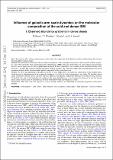Files in this item
Influence of galactic arm scale dynamics on the molecular composition of the cold and dense ISM : I. Observed abundance gradients in dense clouds
Item metadata
| dc.contributor.author | Ruaud, M. | |
| dc.contributor.author | Wakelam, V. | |
| dc.contributor.author | Gratier, P. | |
| dc.contributor.author | Bonnell, I. A. | |
| dc.date.accessioned | 2018-04-26T15:30:05Z | |
| dc.date.available | 2018-04-26T15:30:05Z | |
| dc.date.issued | 2018 | |
| dc.identifier | 252934659 | |
| dc.identifier | c797ca59-8a1c-40d0-93b2-0162e1679013 | |
| dc.identifier | 85045430355 | |
| dc.identifier | 000429549800001 | |
| dc.identifier.citation | Ruaud , M , Wakelam , V , Gratier , P & Bonnell , I A 2018 , ' Influence of galactic arm scale dynamics on the molecular composition of the cold and dense ISM : I. Observed abundance gradients in dense clouds ' , Astronomy and Astrophysics , vol. 611 , A96 . https://doi.org/10.1051/0004-6361/201731693 | en |
| dc.identifier.issn | 0004-6361 | |
| dc.identifier.uri | https://hdl.handle.net/10023/13240 | |
| dc.description | This work has been founded by the European Research Council (Starting Grant 3DICE, grant agreement 336474). The authors are also grateful to the CNRS program "Physique et Chimie du Milieu Interstellaire" (PCMI) co-funded by the Centre National d’Etudes Spatiales (CNES) for partial funding of their work. IAB gratefully acknowledges support from the ECOGAL project, grant agreement 291227, funded by the European Research Council under ERC-2011-ADG. | en |
| dc.description.abstract | Aim. We study the effect of large scale dynamics on the molecular composition of the dense interstellar medium during the transition between diffuse to dense clouds. Methods. We followed the formation of dense clouds (on sub-parsec scales) through the dynamics of the interstellar medium at galactic scales. We used results from smoothed particle hydrodynamics (SPH) simulations from which we extracted physical parameters that are used as inputs for our full gas-grain chemical model. In these simulations, the evolution of the interstellar matter is followed for ~50 Myr. The warm low-density interstellar medium gas flows into spiral arms where orbit crowding produces the shock formation of dense clouds, which are held together temporarily by the external pressure. Results. We show that depending on the physical history of each SPH particle, the molecular composition of the modeled dense clouds presents a high dispersion in the computed abundances even if the local physical properties are similar. We find that carbon chains are the most affected species and show that these differences are directly connected to differences in (1) the electronic fraction, (2) the C/O ratio, and (3) the local physical conditions. We argue that differences in the dynamical evolution of the gas that formed dense clouds could account for the molecular diversity observed between and within these clouds. Conclusions. This study shows the importance of past physical conditions in establishing the chemical composition of the dense medium. | |
| dc.format.extent | 14 | |
| dc.format.extent | 2347121 | |
| dc.language.iso | eng | |
| dc.relation.ispartof | Astronomy and Astrophysics | en |
| dc.subject | Astrochemistry | en |
| dc.subject | Galaxy: evolution | en |
| dc.subject | ISM: clouds | en |
| dc.subject | ISM: evolution | en |
| dc.subject | ISM: kinematics and dynamics | en |
| dc.subject | ISM: molecules | en |
| dc.subject | QB Astronomy | en |
| dc.subject | QC Physics | en |
| dc.subject | Astronomy and Astrophysics | en |
| dc.subject | Space and Planetary Science | en |
| dc.subject | NDAS | en |
| dc.subject.lcc | QB | en |
| dc.subject.lcc | QC | en |
| dc.title | Influence of galactic arm scale dynamics on the molecular composition of the cold and dense ISM : I. Observed abundance gradients in dense clouds | en |
| dc.type | Journal article | en |
| dc.contributor.sponsor | European Research Council | en |
| dc.contributor.institution | University of St Andrews. School of Physics and Astronomy | en |
| dc.identifier.doi | https://doi.org/10.1051/0004-6361/201731693 | |
| dc.description.status | Peer reviewed | en |
| dc.identifier.url | https://arxiv.org/abs/1712.06696 | en |
| dc.identifier.grantnumber | en |
This item appears in the following Collection(s)
Items in the St Andrews Research Repository are protected by copyright, with all rights reserved, unless otherwise indicated.

